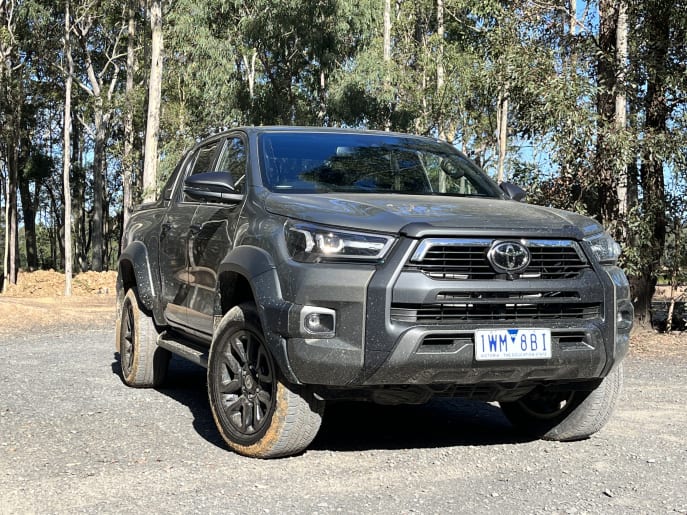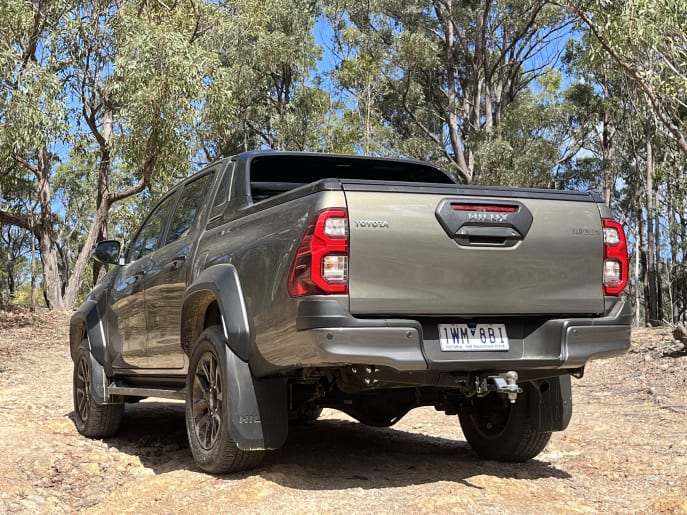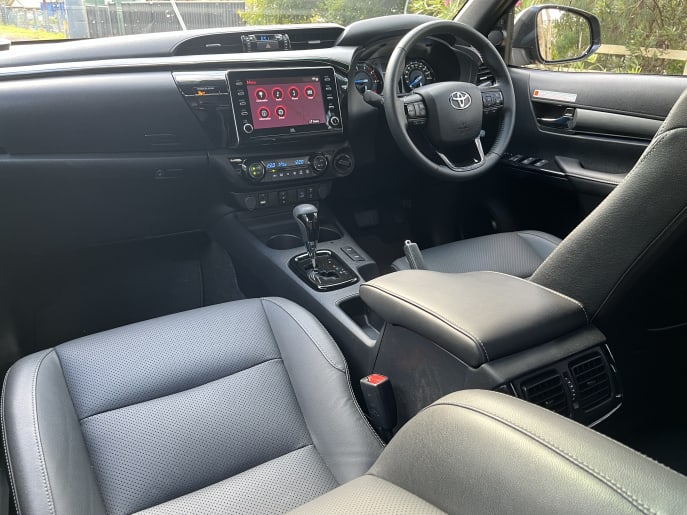The Toyota Hilux has a long-time firm foothold in Australia’s ute market – and the Rogue variant is the pick of the bunch – at least until the range-topping GR Sport arrives here later this year.
But is it as good as the hype would have you believe?
Price and features of the 2023 Toyota HiLux Rogue
The Toyota HiLux 4x4 Rogue 2.8L turbo-diesel automatic double-cab pick-up has a manufacturer suggested retail price of $70,200 (excluding on-road costs).
Standard features include a 8.0-inch touchscreen multimedia system (with satnav, Bluetooth, and Apple CarPlay & Android Auto), a nine-speaker JBL sound system, 18-inch alloy wheels, dual-zone climate control, a front cooler box, a marine-grade carpeted tub, a sports bar, LED tray lights and an electric roller cover.
The Rogue has a new suspension set-up, which includes a wider front stabiliser bar (to suit the new wider front end), stretched front lower control arms, a wider rear differential housing, and, for the first time in a Hilux, a rear stabiliser bar. It now has a wider wheel track front (1670mm) and rear (1705mm), and a taller stance than before, yielding 20mm more ground clearance.
This re-engineering work is aimed at giving the Rogue more composed ride and handling on-road.
Exterior paint choices include Glacier White, Frosted White, Silver Sky, Feverish Red, Graphite, Eclipse Black, Saturn Blue, Nebula Blue, and the Oxide Bronze on our test vehicle.
The Rogue has a 2.8-litre turbo-diesel four-cylinder engine – producing 150kW at 3400rpm and 500Nm at 1600-2800rpm – and it is only available with the six-speed automatic transmission.
This is a proven engine-and-transmission combination, with lots of lowdown torque and in overall performance terms it’s capable of holding its own against such rivals as Ford Ranger and Isuzu D-Max.
It has part-time four-wheel drive (with high- and low-range gearing) and a rear diff lock.
The Rogue is 5320mm long (with a 3085mm wheelbase), 2020mm wide, and 1870mm high. It has a listed kerb weight of 2256kg.
Its interior is function over fancy, but the black leather-accented trim adds some low-key class to the cabin.
The interior is very familiar and, frankly, it’s all starting to feel a bit old.
There are plenty of durable hard plastic surfaces, storage spaces, a reasonable amount of charging points up front – single USB port up front and two 12V sockets and a 240V socket inside the centre console.
The driver’s seat is power-adjustable and comfortable.
Apple CarPlay is easy enough to get working via the Rogue’s multimedia system, but the screen is too small, and overall the Rogue feels a bit underdone in the tech department.
The back row is more of a space suited to seating three children or two adults, with a reasonable amount of space – head, knee- and legroom.
There are bottle holders in each door, and the fold-down arm-rest has a dual cup holder.
Driving the 2023 Toyota HiLux Rogue
On-road the Rogue has improved but it’s still less refined and settled than the likes of Ford Ranger Wildtrak or Raptor, or even Nissan Navara Warrior.
It remains a firm-riding ute but the re-engineered suspension, stabiliser bars front (widened) and rear (new for Rogue), control arms extended and lower strut arms moved further outwards (which has altered the spring and dampener angle for better functionality), as well as wider wheel track (there’s now a 35mm difference between front and rear), all help to give the Rogue a more composed driving feel on sealed surfaces and through corners.
Stopping power is new for the Rogue with disc brakes on every wheel; 338mm at the front and 312mm at the rear. I can confirm the Hilux is capable of swift and precise emergency braking.
Also new to this newest Rogue are 18-inch alloy wheels, rather than the 17s that were on the previous-gen Rogue. No problem there, but many Rogue buyers will likely replace that wheel-and-tyre combination with a 17-inch set soon after purchase.
While there have been some improvements to noise, vibration and harshness levels over previous Hiluxes, those in the cabin will still experience some exterior noise, especially once you hit rough dirt roads.
The Hilux’s 2.8-litre four-cylinder turbo-diesel engine and six speed auto are unchanged and work well together, having been tuned over the years into a pairing that, performance-wise, has certainly improved.
Along gravel tracks and dirt roads, the suspension-enhanced Rogue still tended to be more than a bit skippy over unsealed surfaces, pockmarked with potholes and corrugations. But we weren’t carrying much gear – only a vehicle-recovery kit, air compressor, first-aid kit, a set of four MaxTrax and a few tools – so you can forgive it for exhibiting the expected jitters of an unladen ute.
The Rogue hasn’t lost a step in terms of low-range 4WDing. It has the four-wheel drive mechanicals, reliable low-range gearing and engine braking, plenty of torque across a broad rev range, and precisely calibrated off-road traction control. It also has rear diff lock.
In terms of off-road-relevant measurements: the Rogue has an official wading depth of 700mm, and adequate approach (31 degrees) and departure (23 degrees) angles. Toyota does not list a ramp-over angle. You do get an extra 20mm of running ground clearance in the new Rogue (265mm) over the previous one, due to the upgraded suspension package.
Weirdly, the Rogue is supposedly the Hilux line-up’s most off-road-focused variant – that is until the GR Sport arrives here later in 2023 – but it's shod with highway tyres that aren't suited to 4WDing at all. If you’re planning to use your Rogue as a touring vehicle, replace those standard tyres with a set of decent all-terrains.
In terms of packability for touring, the Rogue’s tub is 1570mm long (1105mm between the wheel-arches), 1645mm wide and the load space itself is 495mm deep.
It has an electric roller cover, a 12V socket, LED lights, marine-grade carpet (velcroed into place), and two tie-down points (not enough). The roller cover’s drum, in which the roller cover is housed when the tub is open, impacts your packing space in the tub.
Towing capacities are 750kg (unbraked) and 3500kg (braked).
Payload is listed as 1000kg, Gross Vehicle Mass (GVM) is 3510kg, and Gross Combined Mass (GCM) is 6900kg.
What we think of the 2023 Toyota HiLux Rogue
Even though Toyota consistently seems to do the bare minimum to keep its customers coming back for more, the new Rogue is much more than just a sticker pack. The suspension upgrade has made a substantial difference to this ute – not in terms of any enhancement to its 4WD capability, but it has definitely improved this ute’s on-road ride and handling.
The Rogue still lags behind plenty of its rivals in terms of refinement, comfort, and all-round drivability, but despite that it still holds plenty of appeal for those who appreciate a good ute.



















